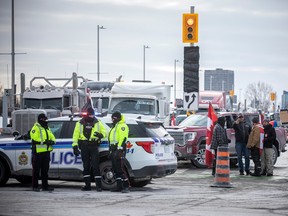Just a single-page summary of the traffic plan was given to the city on Jan. 29, the day after the first of the protesters began arriving in the capital.

The Ottawa Police Service kept the city in the dark in the days leading up to last winter’s convoy occupation of downtown Ottawa, withholding intelligence reports, important risk assessments and its key 46-page traffic management plan, the city’s auditor general says in a report released Wednesday.
The result was ineffective planning, disruption to OC Transpo service and sometimes “chaotic” police requests of the city’s traffic team which were unfeasible to implement, the report said.
Sign up to receive daily headline news from Ottawa Citizen, a division of Postmedia Network Inc.
Thanks for signing up!
A welcome email is on its way. If you don't see it, please check your junk folder.
The next issue of Ottawa Citizen Headline News will soon be in your inbox.
“(W)hile City departments were engaged by the OPS prior to the convoy’s arrival, the intelligence shared with the City was not sufficient to allow the City to conduct effective planning for the event,” Auditor General Nathalie Gougeon wrote in her 18-page report.
Just a single-page summary of the traffic plan was given to the city on Jan. 29, the day after the first of the protesters began arriving in the capital, the report noted.
“Despite the OPS’s plan being based on information that was constantly changing and the fact that the behaviour of incoming protesters was unpredictable, sharing the established traffic plan, when it was in a sufficiently finalized state, would have enabled the City to be better prepared,” Gougeon said.
That left OC Transpo in a lurch as it tried to adapt its routes and schedules to accommodate the protest.
“Transit Services found itself in the position of having to re-route, create detours, post signage, and get information out to the public all at the last minute,” Gougeon wrote. “Having the OPS’s traffic plan would have at the very least made Transit Services aware of the planned road closures, road restrictions, staging / stacking areas, and ingress and egress routes.”
Nor did police bring the city’s traffic management team on board when it was developing its plan, leaving the city little time to adjust traffic signal time or get messages out on electronic billboards. The city’s traffic team was often scrambling to meet “chaotic requests” from police.
“During the first two weeks of the convoy protest, the OPS did not leverage the expertise of, nor collaborate with the Traffic Management unit for ongoing traffic management. The City found itself reacting to OPS requests (e.g., assistance with setting up barriers) related to traffic. Traffic Management found the situation chaotic as requests were being made of them (which were not always feasible), but they were not privy to the communications related to the traffic plan behind the requests.”
But not all the blame belongs to the police, Gougeon said.
“Despite this, the City did not formally request that the OPS include them in traffic planning prior to the convoy’s arrival, nor throughout the first two weeks of the event,” she wrote.
A fundamental problem with the communication between police and the city was the OPS’s failure to communicate with the city’s Office of Emergency Management (OEM), which has the overall responsibility to plan and prepare for emergency situations. While police talked with individual departments like Ottawa Fire, paramedics, transit and traffic management as the protesters neared the capital, the OEM wasn’t engaged. In a city used to demonstrations on Parliament Hill, protests aren’t usually considered to be city emergencies.
That police work with the OEM “when the size and nature of a protest (or other similar event) has the potential for significant City impacts” was one of four recommendations in the auditor general’s report.
A second was that police do a better job of sharing intelligence. Police can’t share confidential information it obtains from other agencies, but the auditor recommends it share what it can with city officials with the appropriate security clearance. “This will enable the City to receive more timely and detailed intelligence to aid responses to future events,” the report said.
The report also stressed the importance of co-operation between police media relations and the city’s communication department. Gougeon said the two communications teams worked well together, but she recommended a formal policy be drawn up to ensure that continues.
The auditor’s report into the police response was one of three released Wednesday, with others examining the city’s response to the demonstration and the response of the Police Services Board. Gougeon limited her investigation into the police-city cooperations so as to not duplicate other investigations already underway, such as the OPS’s own internal review.
Gougeon also noted that her audit has the benefit of hindsight. Overall, Gougeon said, the police worked well with city staff during the more than three-week demonstration, praising the “tireless efforts” of its senior leadership and officers who worked under “the harshest conditions.”
“We can conclude that, to the extent possible, the OPS and the City worked effectively together towards a common objective and each organization was able to support the other in providing resources, infrastructure and expertise, when available.”
The reports are publicly available on the Auditor General’s website at oagottawa.ca


